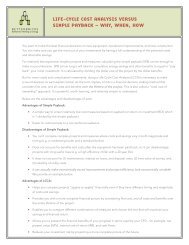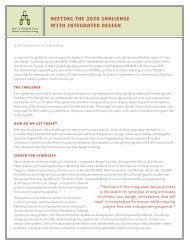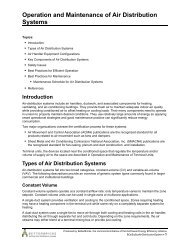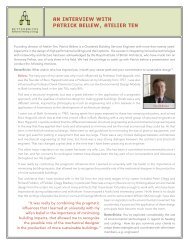VAV box reheat is active, damper is open to maximum ... - BetterBricks
VAV box reheat is active, damper is open to maximum ... - BetterBricks
VAV box reheat is active, damper is open to maximum ... - BetterBricks
You also want an ePaper? Increase the reach of your titles
YUMPU automatically turns print PDFs into web optimized ePapers that Google loves.
How <strong>to</strong> Find the Problem(s) by Inspection<br />
Inspection Step 1<br />
Inspect the direct-digital-control (DDC) system <strong>to</strong> see if the AHU <strong>is</strong> in cooling or heating mode. If it <strong>is</strong> in<br />
heating mode, then the zone <strong>reheat</strong> <strong>is</strong> providing the additional heat that the AHU can’t provide. Th<strong>is</strong> can<br />
occur during morning warm-up.<br />
Inspection Step 2<br />
If the <strong>damper</strong> control has been overridden in the DDC programming, determine why before correcting the<br />
problem. Some reasons for override may be:<br />
• The space has a high minimum make-up-air requirement such as for a fume or exhaust hood.<br />
• The <strong>damper</strong> was overridden during the cooling season <strong>to</strong> meet a temporary need for space<br />
temperature and was not subsequently reset.<br />
• Tenant complaints about poor air circulation, or “dead-air” conditions.<br />
The first condition has no simple solution and may actually be part of the original design. The second and<br />
third conditions require a review of the space-cooling loads <strong>to</strong> ensure that proper primary air <strong>is</strong> available<br />
under all conditions. The diffuser d<strong>is</strong>tribution should also be checked <strong>to</strong> make sure the supply air <strong>is</strong> not<br />
short-circuiting <strong>to</strong> the return-air plenum.<br />
Inspection Step 3<br />
Inspect the <strong>damper</strong> opera<strong>to</strong>r <strong>to</strong> make sure it <strong>is</strong> operating properly. Cycle the <strong>damper</strong> using the DDC<br />
system while observing its response locally. If there <strong>is</strong> no change in position, the <strong>damper</strong> opera<strong>to</strong>r may<br />
have failed. A DDC technician can determine whether th<strong>is</strong> <strong>is</strong> the case. Make sure there are no obvious air<br />
leaks at the flex connection <strong>to</strong> the <strong>VAV</strong> <strong>box</strong>.<br />
Inspection Step 4<br />
The AHU may have a pressure-control problem that <strong>is</strong> starving the <strong>VAV</strong> <strong>box</strong> of primary air, forcing the<br />
<strong>damper</strong> <strong>to</strong> be wide <strong>open</strong> just <strong>to</strong> meet minimum airflow requirements. Inspect the AHU static pressure (SP)<br />
setpoint (in inches of water, typically denoted as "wg) and variable-speed-drive (VSD) speed <strong>to</strong> see if the<br />
static pressure design conditions are being met. Th<strong>is</strong> condition can also be caused by excessive duct<br />
leakage or a closed fire <strong>damper</strong> upstream of the <strong>VAV</strong> <strong>box</strong>.<br />
Inspection Step 5<br />
In conjunction with Inspection Step 4, the AHU static pressure may be <strong>to</strong>o high and the <strong>VAV</strong> <strong>box</strong> <strong>damper</strong><br />
actua<strong>to</strong>r does not have enough <strong>to</strong>rque <strong>to</strong> overcome it. Th<strong>is</strong> typically occurs in <strong>VAV</strong> <strong>box</strong>es close <strong>to</strong> the air<br />
handler where the duct static pressure <strong>is</strong> the highest.<br />
How <strong>to</strong> Confirm the Problem(s) by Trend Logging<br />
Trend log the following:<br />
• AHU supply-air temperature (SAT)<br />
• AHU static pressure (SP)<br />
• <strong>VAV</strong> <strong>box</strong> SAT, if available<br />
• Damper position<br />
• Heating coil percent capacity (feedback and not output from the DDC system)<br />
Graph the heating coil percent with respect <strong>to</strong> the other four points. Look for correlations in the trends.<br />
Produced by <strong>BetterBricks</strong>, the commercial initiative of the Northwest Energy Efficiency Alliance<br />
BOpTlsMstrPrb22.doc • 2









